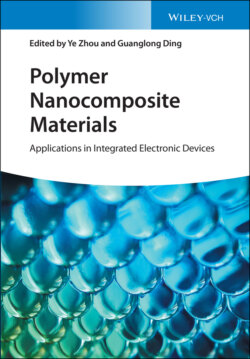Читать книгу Polymer Nanocomposite Materials - Группа авторов - Страница 44
2.4.4 Temperature Sensor
ОглавлениеCPCs served as temperature sensors show many popular applications for thermal detectors, over-temperature protection devices and self-regulating heaters, etc. [158]. The temperature sensing behavior of CPCs is based on positive temperature coefficient (PTC) effect and negative temperature coefficient (NTC) effect. Conceptually, PTC and NTC of thermistors display a conspicuous increase and a succeeding gradual decrease in electrical resistance with increasing temperature, respectively [122]. It is believed that the PTC effect arises from the expansion or the melting of the matrix, which would increase the distance between conductive elements. While a flocculated structure formed at elevated temperatures, resulting in NTC effect.
Chlorinated poly(propylene carbonate) (CPPC)/CB foam composite with a nearly-linear NTC effect of resistance is reported by Cui et al. [159]. As shown in Figure 2.10a, the relative resistance of solid CB/CPPC composites demonstrates both PTC and NTC effect with increasing the temperature from 25 to 70 °C. However, the resistivity-temperature performance of CPPC/CB foam composite exhibits a significant NTC effect with temperature variation (Figure 2.10b). The CB content also shows influence on the sensing behavior of CPPC/CB foam and the NTC effect declines with the increase of CB content. The schematic diagram of temperature sensing mechanism for the CPPC/CB foam composite is demonstrated in Figure 2.10c. The cell walls of the foam were squeezed by expanded gas and the thickness of the cell walls was reduced during the heating. Therefore, the distance between adjacent CB particles was decreased and more conductive pathways formed in polymer matrices, leading to the decrease of the resistance.
Lee and coworkers [160] fabricated graphite nanofibers (GNF) and CB filled high density polyethylene (HDPE) hybrid composites with PTC effect and explored the influence of conductive filler content on the PTC behavior of the hybrid composite. The relationship between resistivity and temperature of the HDPE/CB (80/20) and the HDPE/CB (75/25) with various GNFs contents is demonstrated in Figure 2.10d,e, respectively. It is found that the incorporation of a small quantity of GNFs into HDPE/CB composite shows significant enhancement in reproducibility and PTC intensity. The incorporation of GNFs would hinder the migration of conductive nanoparticles and the shape deformation of the polymer resin, thus resulting in this phenomenon.
Figure 2.10 (a) The normalized resistance (R/R0) variation with temperature from 25 to 70 °C for the solid CB/CPPC composites with 2.5 vol% CB. (b) The normalized resistance (R/R0) variation with temperature from 25 to 70 °C for CPPC/CB foams with 0.20, 0.30, and 0.45 vol% CB. (c) Schematic illustration of microstructural evolution in CPPC/CB foams during heating process. Source: (a)–(c) Reproduced with permission. [159] Copyright 2018, The Royal Society of Chemistry. (d) The curve of resistivity vs. temperature for the HDPE/CB (80/20) with different content of GNFs. (e) The curve of resistivity vs. temperature for the HDPE/CB (75/25) with different content of GNFs. Source: (d)–(e) Reproduced with permission. [160] Copyright 2009, Elsevier Ltd.
The temperature-resistivity intensity (intensity of positive temperature coefficient [IPTC] and intensity of negative temperature coefficient [INTC]) of CPCs is an essential index for temperature sensors. A low INTC value is required for a preferable temperature sensor to output large response toward temperature stimuli [161]. To increase the IPTC intensity, many efforts have been made to remove the NTC effect. It is accepted that the NTC effect is due to the reaggregation of the conductive nanofillers in the polymer matrix and recovery of disconnected conductive pathways [162]. The usual method is using crosslinking agent or radiations, which could increase the viscosity of polymer matrix and prevent the reaggregation of conductive fillers, thus eliminating the NTC effect [163, 164]. Lu et al. [162] fabricated nylon6 (PA6)/PS/(poly(styrene-co-maleic anhydride) (SMA)–CB) composite with especial interface morphology. The PA6/PS/(SMA–CB) composites showed stronger IPTC than PA6/PS/CB and NTC effect was eliminated. The special interfacial morphologies and low percolation threshold are responsible for elimination of NTC and stronger IPTC.
